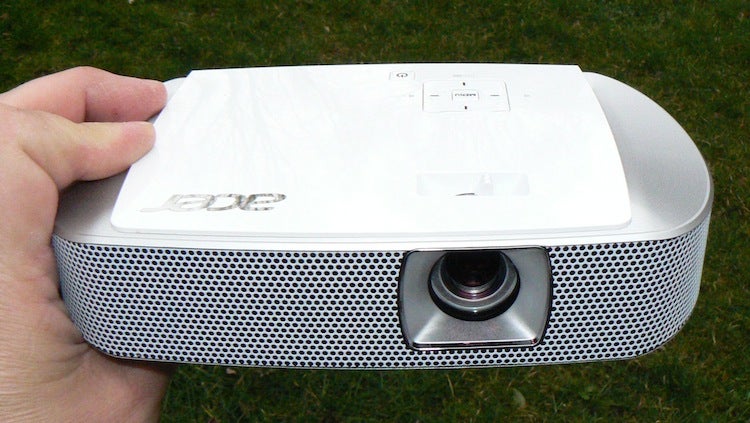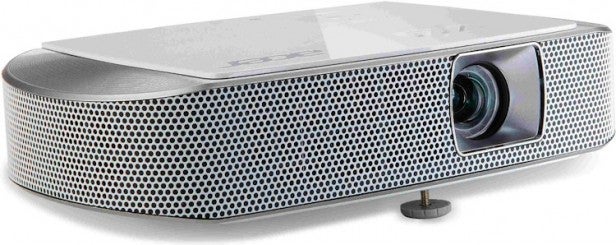Acer K137 Review
Acer K137
A tiny projector with a unique talent

Sections
- Page 1 Acer K137 Review
- Page 2 Picture Quality Review
- Page 3 Sound and Conclusions Review
Verdict
Pros
- Really cute pint-sized design
- Uniquely powerful built-in audio performance
- Bright, colourful picture quality
Cons
- Below par black level response
- Presentations text looks a bit rough
- 16:9 video looks a touch stretched
Key Specifications
- Review Price: £400.00
- Ultra-portable DLP LED projector
What is the Acer K137?
The K137 is an ultra-small ‘travel’ projector that uses DLP technology and offers such surprisingly strong features as a 1280×800 native resolution, 3D playback, a built-in USB card reader, and most startlingly of all for a ‘pocket’ projector, a sound system that actually sounds decent rather than the sonic equivalent of two cans and a piece of string.
Acer K137: Design and Features
The K137 is a true one-off on the design front. With its rounded corners and distinctive combination of gloss white panels and light silver grille it looks more like a mini hovercraft than a projector. Except, of course, for the little recessed projection lens on the right side of the front edge.
It’s a very attractive design (it picked up a coveted iF product design award), and the build quality feels decent too – despite the fact that its 1.6in x 7.4in x 4.6in bodywork weighs just 1.1 pounds. Plus there’s a very good reason for the grilled part of the bodywork beyond mere aesthetic fanciness, namely that it’s the cover for a ‘360-degree’ audio system funnelling a 2 x 3W stereo speaker system out with much more room to breathe than you’d normally get from a small projector. There’s even SRS Wow audio processing onboard, designed to deliver a wider soundstage and more dynamic, open performance from the speakers.
You might also like:
- ROUND-UP: Best Projectors
- REVIEWS: Projectors under £500
- ALTERNATIVES: BEM Kickstand

We guess 6W doesn’t sound all that much on paper when you think that TVs often talk in terms of 20W and more these days. But sound quality isn’t just about power; it’s also about how that power is used, and in this respect the K137’s uniquely audio focussed design is very promising.
You might be wondering why sound matters on a device as focussed on visuals as a projector. But if you are you’ve clearly never tried using a small projector in either a business or casual home environment, where the last thing you want to have to do is try and find an external audio solution to provide the sonic accompaniment to your flashy Powerpoint presentation, corporate video, sports event or home movie. With projectors like the K137 you just want to be able to take them out of a cupboard or pocket, plonk them down, hook up your source and immediately enjoy a full AV experience.
There are plenty of options for hooking up your sources, including an HDMI port with video, data and MHL (mobile phone) playback support; type A USB and micro SD slots for direct playback of any Microsoft Office documents (ie Word, Excel and Powerpoint) as well as PDF files; and even a Universal i/o port.
The K137 is also DLNA-compliant, meaning that you can stream photos, music or video from Android/iOS/Windows smartphones, tablets and notebooks via an optional USB adapter.
The impressive first impressions continue with ithe K137’s picture specifications. Its native resolution of 1280×800 ticks both the HD Ready and widescreen (albeit 16:10 rather than the usual 16:9 aspect ratio) boxes, while its claimed contrast ratio of 10,000:1 is crazily high for an ultra-portable projector.
Its DLP engine is illuminated by LEDs with a claimed lifespan of between 20,000 and 30,000 hours (depending on which lamp mode you use). Or to put it another way, the K137’s bulbs won’t ever need to be changed. Once they die that’s basically the end of the projector’s life. Up to that point they should pump out between 560 and 700 ANSI lumens of brightness depending on which lamp mode you’re using – figures which are again strikingly high for an ultra-portable machine.
Colour should also stay reasonably true throughout the life of the projector thanks to Acer’s ColorSafe II system, which adjusts the picture settings to compensate for any colour decay over prolonged use.
From these specs it’s no surprise to find Acer’s marketing for the K137 talking about it being a gaming and video projector despite its business-friendly Microsoft Office parsing. If it turns out to genuinely be as multipurpose as it sounds on paper, its £400 price point will start to look pretty reasonable.
Acer K137: Set Up
Convenience-based projectors like the K137 obviously need to be easy and quick to get up and running. And the K137 hits this target nicely.
For a start, like most LED-lit projectors, it fires up and shuts down instantly; there’s no need to wait while it warms up and down. It doesn’t feature any optical zoom or image shifting either, so for most people getting an image on a screen or wall will just involve plonking it on a desk, adjusting the focus ring around the lens, connecting a source and maybe using the provided keystone adjustment to get the edges of the image perpendicular.
Don’t forget that the built-in audio will negate the need to find an external audio source.
One nice little set up touch we much appreciated was the facility to tell the projector the colour of the wall you’re projecting on to, so that it can adjust its image settings to compensate.

